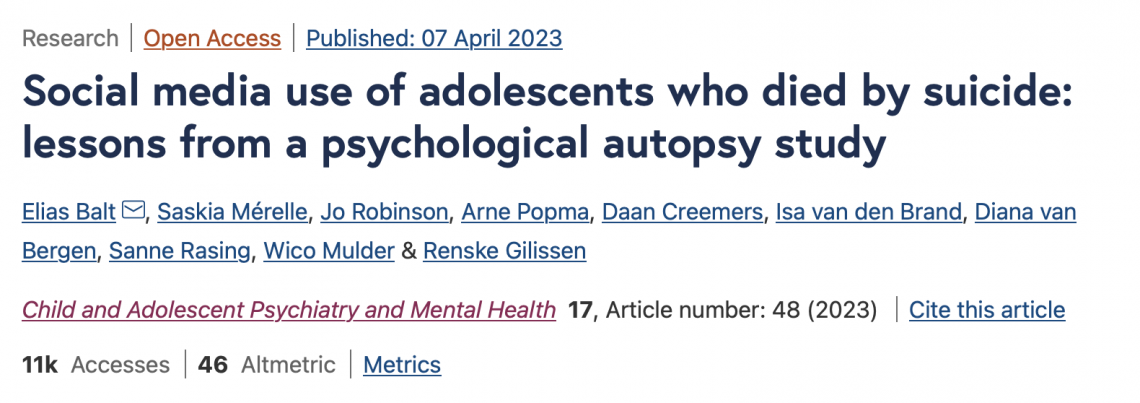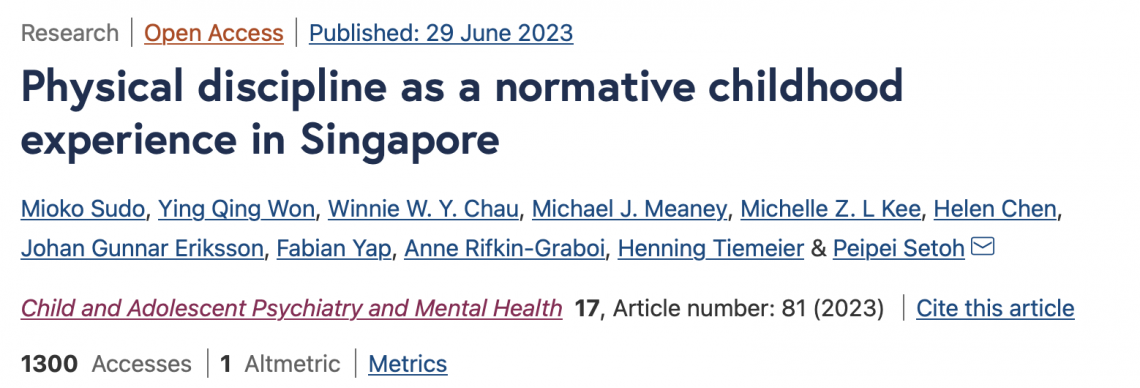CAPMH Corner (Updated Sep 2023)
By: Lakshmi Sravanti, India, Associate Editor, CAPMH
Child and Adolescent Psychiatry and Mental Health (CAPMH) is the official IACAPAP Journal. The "CAPMH Corner" of the September 2023 issue of IACAPAP Bulletin summarizes the following three studies recently published in CAPMH Secure attachment predicts lower societal cost amongst severely antisocial adolescents (Bachmann et al., (2023), Social media use of adolescents who died by suicide: lessons from a psychological autopsy study (Balt et al., 2023) and Physical discipline as a normative childhood experience in Singapore (Sudo et al., 2023).
Bachmann et al., (2023) lay emphasis on the significant economic consequences of antisocial behaviour in adolescents and set out to explore the hypothesis that the attachment quality of adolescents to their parents might predict economic costs for society in a high-risk sample of adolescents with substantial levels of antisocial behaviour.
The authors use data from the Study of Adolescents’ Family Experiences (SAFE), a randomised controlled trial of Functional Family Therapy (FFT) that was carried out in the UK from 2008 to 2011 (Humayun et al., 2017) in which 111 adolescents (10-17 years; 71% male) were recruited. They carry out a structured interview with the primary caregiver to collect socidemographic data and use the short version of the Alabama Parenting Questionnaire (APQ-15) to evaluate conduct disorder symptoms of the adolescent and parenting style respectively. They assess the subjects using the Self Report Delinquency (SRD) questionnaire, the “callous-unemotional (CU) traits” subscale of the Antisocial Process Screening Device (APSD), the Wechsler Abbreviated Scale of Intelligence (WAIS), and Child Attachment Interview (CAI). The team analyses the data using generalised linear models that do not assume a normal distribution, however, a Tweedie distribution was assumed to account for the left-skewness of the cost data. They perform the Mann-Whitney-U test to compare the means of attachment to mother and father.
The team reports a very high rate of self-reported delinquent acts and CU personality traits. They note significantly lower rates of attachment security (both to mothers and to fathers) than in normal risk samples. Attachment insecurity to fathers and CU traits predicted highly significant increased cost (p = 0.001); secure attachment to both parents predicted further cost savings than to father alone (p = 0.001); other predictors of cost were older age, youth with a lower IQ, and those with higher delinquency level.
The authors mention the study strengths – a comprehensive assessment of the sample using a multi-method, multi-informant approach; and statistical analyses done adjusting for potential confounders, and acknowledge its limitations – a cross-sectional design; missing data on attachment (as many adolescents came from non-intact families); and lack of generalizability as the study sample was very high-risk and already in the social care system in the UK. They conclude that maternal overweight/obesity, particularly with gestational diabetes, is linked to increased behavior problems in offspring and early gut microbiota, feeding practices, and maternal factors also play a significant role. They suggest the provision of evidence-based parenting programmes to support parental sensitivity and child attachment quality to improve the wellbeing of children and families and reduce societal economic costs.
Balt et al., (2023) elaborate the influence of social media on the mental health of adolescents. They set out to elucidate the meaning of social media in the lives of adolescents who died by suicide and to examine its effect on their wellbeing and distress. They also aim to identify the needs of adolescents and next-of-kin in relation to digital suicide prevention strategies and understand the challenges next-of-kin faced in talking to young people about safe social media use.
The authors use data from an observational, psychological autopsy study concerning adolescent suicide in the Netherlands (Mérelle et al., 2020). They design a qualitative study to interview one or both parents of the adolescent (primary informants) and other family members and peers (next-of-kin), teachers and health care professionals (secondary informants). However, they do not include data collected from teachers and health care professionals mentioning that their day-to-day contact with the adolescents was limited. They conduct 37 interviews with parents and 18 interviews with peers of 35 deceased adolescents (18 girls and 17 boys). The age of the victims ranged from 14 to 19 years, with a mean age of 17 years. They recruit primary informants through their general practitioner and secondary informants through the primary informants. They conduct post hoc explorative analyses on the psychological autopsy data by employing Interpretative Phenomenological Analysis.
The team reports that all the deceased adolescents used social media. They elucidate the following themes related to the harmful effects of social media such as “dependency and excessive social media use”, “social comparison and distorted perceptions about mental health”, “triggers and imitation”, “cultivation of a suicidal identity”, “challenges and impulsive behaviours”, and “victimization and entrapment”. In addition, they also discuss themes such as “supportive use of social media”, “experiences with monitoring and engaging adolescents about social media”, “unfamiliarity”, “online anonymity” and “restriction and resistance”. They recommend exploring strategies for youth’s self-advocacy and self-efficacy and underscore the need to equip adolescents with handles for conscientious and responsible social media use.
The authors acknowledge the limitations of their study: lack of a control sample, the focus of the study on risk factors of suicide alone and not protective factors, its lack of focus on the role of online influencers and the possibility of recall bias. They conclude by highlighting the importance of equipping young people, next-of-kin and policymakers with knowledge and skills to create a safer online environment. They suggest future research to examine the influence of virtual social networks in sustaining suicidal thoughts and behaviour, and investigate the effectiveness of digital interventions such as moderated peer support and the use of positive role models.
Sudo et al., (2023) discuss the cultural normativeness theory and lay out a context to examine the normativeness of parental physical discipline in Singapore. They recruit participants as part of the most comprehensive longitudinal birth cohort study in Singapore, Growing Up in Singapore Towards healthy Outcomes (GUSTO) study (Soh et al., 2014).
The team recruits 710 children (340 girls, 370 boys) with data on parenting at one or more assessments at ages 4.5, 6, 9, and 11 years. They collect data by using Parenting Styles and Dimensions Questionnaire—Short Version (PSDQ) to obtain maternal reports of parenting when children are age 4.5 and 11, and maternal and paternal reports of parenting when children are age 9, Alabama Parenting Questionnaire (APQ) to obtain maternal and paternal reports of parenting when children are age 6 and the Parental Bonding Instrument for Children (PBI-C) to obtain child reports on their parents’ parenting when they are age 9. They assess the prevalence of physical discipline of children at four different ages using parental self-reports of physical discipline in the PSDQ at the age 4.5, 9, and 11 assessments, and the APQ at the age 6 assessment. They explore the change in the prevalence of physical discipline from early to middle childhood in 611 children with maternal reports on their own and the fathers’ use of physical discipline in the PSDQ, and data on age at the time of assessment, in at least one assessment at age 4.5, 9, and 11 years. They also examine the relationship between parents’ self-reported frequency of using physical discipline in the PSDQ and children’s reports on their parents’ parenting in the PBI-C at age 9. They perform a generalized linear mixed model to analyse whether children’s age predicted their exposure to physical discipline and linear regression analyses to assess whether children’s exposure to physical discipline predicted their evaluation of their parents’ parenting.
The authors report a prevalence of 81 to 94% of use of at least one physical discipline. They note a decrease in this prevalence from age 4.5 to 11 years (B = − 0.14, SE = 0.01, OR = 0.87, p < 0.001). Mothers’ self-reported frequency of using physical discipline did not significantly relate to how children rated their mothers’ parenting. Fathers’ use of physical discipline is significantly and negatively associated with both their warmth and autonomy granting. The authors mention that their study “was not adequately designed to determine finegrained peaks and valleys in the prevalence of physical discipline over childhood, as the PSDQ was administered at unequal intervals, with at least a few years of interval between each assessment” and suggest future research to elucidate whether within-person variance in cognitive skills and parent–child relation associated with exposure to physical discipline, to comprehensively examine how physical discipline could impact child development in Singapore, and to understand whether “repair” behaviors moderate the impact of physical discipline.
REFERENCES:
- Bachmann, C.J., Humayun, S., Stevens, M. et al. (2023) Secure attachment predicts lower societal cost amongst severely antisocial adolescents. Child Adolesc Psychiatry Ment Health 17, 56. https://doi.org/10.1186/s13034-023-00598-8
- Balt, E., Mérelle, S., Robinson, J. et al. (2023) Social media use of adolescents who died by suicide: lessons from a psychological autopsy study. Child Adolesc Psychiatry Ment Health 17, 48. https://doi.org/10.1186/s13034-023-00597-9
- Humayun, S., Herlitz, L., Chesnokov, M., et al. (2017). Randomized controlled trial of Functional Family Therapy for offending and antisocial behavior in UK youth. J Child Psychol Psychiatry 58(9): 1023–32.
- Mérelle, S., van Bergen, D., Looijmans, M., et al. (2020). A multi-method psychological autopsy study on youth suicides in the Netherlands in 2017: Feasibility, main outcomes, and recommendations. PLoS One 15(8 August).
- Soh, S. E., Tint, M. T., Gluckman, P. D., et al. (2014) Cohort profile: growing up in Singapore Towards healthy Outcomes (GUSTO) birth cohort study. Int J Epidemiol 43(5), 1401–9.
- Sudo, M., Won, Y.Q., Chau, W.W.Y. et al. (2023) Physical discipline as a normative childhood experience in Singapore. Child Adolesc Psychiatry Ment Health 17, 81. https://doi.org/10.1186/s13034-023-00632-9




